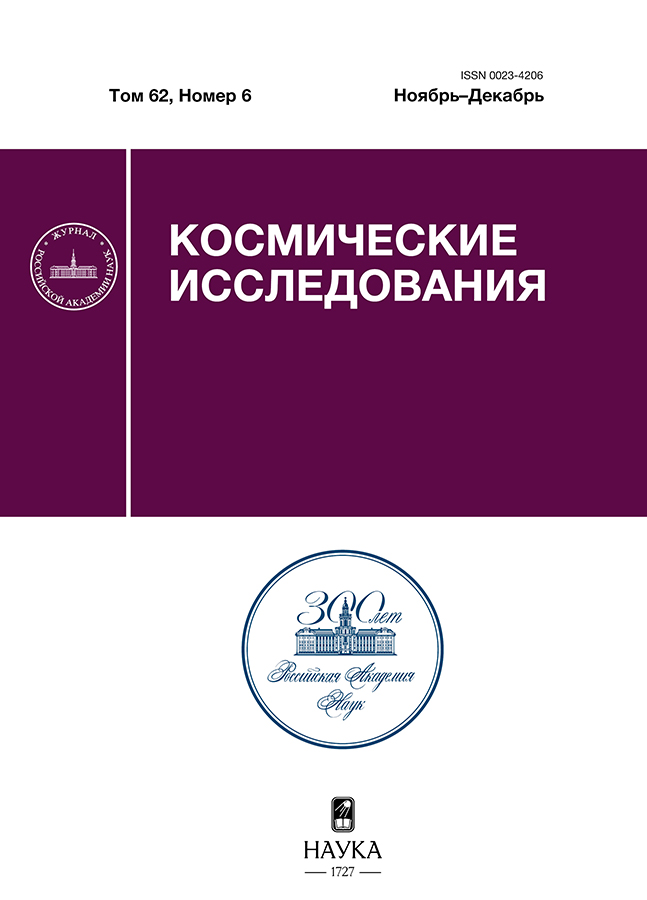Нейтронное излучение лунной поверхности на полюсах
- 作者: Митрофанов И.Г.1, Санин А.Б.1, Литвак М.Л.1, Головин Д.В.1, Дьячкова М.В.1, Аникин А.А.1, Лукьянов Н.В.1
-
隶属关系:
- Институт космических исследований РАН
- 期: 卷 62, 编号 6 (2024)
- 页面: 663-672
- 栏目: Articles
- URL: https://bulletin.ssaa.ru/0023-4206/article/view/672794
- DOI: https://doi.org/10.31857/S0023420624060102
- EDN: https://elibrary.ru/IFHRGI
- ID: 672794
如何引用文章
详细
Лунная поверхность в окрестности полюсов обладает особыми свойствами по сравнению с поверхностью на экваторе и на умеренных широтах. В полярном реголите содержится в достаточно большом количестве водяной лед, который существенно влияет на возникающее под действием галактических космических лучей нейтронное излучение. Также, температура полярного реголита может иметь предельно низкие значения около 25 К, вследствие чего тепловая компонента нейтронного потока частично удерживается в гравитационном поле.
На основе численного моделирования нейтронного излучения лунной поверхности показаны его главные особенности для полярных районов по сравнению с экваториальными: значительное уменьшение отношения потоков эпитепловых и тепловых нейтронов вследствие увеличения концентрации водорода в реголите и существенное увеличение плотности тепловых нейтронов вблизи поверхности вследствие гравитационного удержания.
全文:
作者简介
И. Митрофанов
Институт космических исследований РАН
Email: golovin@np.cosmos.ru
俄罗斯联邦, Москва
А. Санин
Институт космических исследований РАН
Email: golovin@np.cosmos.ru
俄罗斯联邦, Москва
М. Литвак
Институт космических исследований РАН
Email: golovin@np.cosmos.ru
俄罗斯联邦, Москва
Д. Головин
Институт космических исследований РАН
编辑信件的主要联系方式.
Email: golovin@np.cosmos.ru
俄罗斯联邦, Москва
М. Дьячкова
Институт космических исследований РАН
Email: golovin@np.cosmos.ru
俄罗斯联邦, Москва
А. Аникин
Институт космических исследований РАН
Email: golovin@np.cosmos.ru
俄罗斯联邦, Москва
Н. Лукьянов
Институт космических исследований РАН
Email: golovin@np.cosmos.ru
俄罗斯联邦, Москва
参考
- Drake D.M., Feldman W.C., Jakosky B.M. Martian neutron leakage spectra // J. Geophys. Res. 1988. V. 93. Iss. B6. P. 6353–6368. https://doi.org/10.1029/JB093iB06p06353.
- Masarik J., Reedy R. Gamma ray production and trans- port in Mars // J. Geophys. Res.: Planets. 1996. V. 101. Iss. E8. P. 18891–18912. https://doi.org/10.1029/96JE01563
- Woolum D.S., Burnett D.S., Furst M. et al. Measurement of the lunar neutron density profile // The Moon. 1975. V. 12. P. 231–250. https://doi.org/10.1007/BF00577879.
- Feldman W.C., Barraclough B.L., Maurice S. et al. Major compositional units of the Moon: Lunar Prospector thermal and fast neutrons // Science. 1998. V. 281. P. 1489–1493. doi: 10.1126/science.281.5382.1489.
- Feldman W.C., Maurice S., Binder A.B. et al. Fluxes of fast and epithermal neutrons from Lunar Prospector: Evidence for water ice at the lunar poles // Science. 1998. V. 281. P. 1496–1500. doi: 10.1126/science.281.5382.1496.
- Maurice S., Lawrence D.J., Feldman W.C. et al. Reduction of neutron data from Lunar Prospector // J. Geophys. Res. 2004. V. 109. Art.ID. E07S04. doi: 10.1029/2003JE002208.
- Mitrofanov I.G., Bartels A., Bobrovnitsky Y.I. et al. Lunar exploration neutron detector for the NASA lunar reconnaissance orbiter // Sp. Sc. Rev. 2010. V. 150 P. 183–207.
- Mitrofanov I.G., Sanin A.B., Boynton W.V. et al. Hydrogen mapping of the lunar south pole using the LRO neutron detector experiment LEND // Science. 2010. V. 330. P. 483–486.
- Colaprete A., Schultz P., Heldmann J. et al. Detection of water in the LCROSS ejecta plume // Science. 2010. V. 330. P. 463–468. doi: 10.1126/science.1186986
- Sanin A.B., Mitrofanov I.G., Litvak M.L. et al. Hydrogen distribution in the lunar polar regions // Icarus. 2017. V. 283. P. 20–30. https://doi.org/10.1016/j.icarus.2016.06.002
- Allison J., Amako K., Apostolakis J. et al. Recent developments in GEANT4 // Nuclear Instruments and Methods in Physics Research. 2016. V. 835. P. 186–225. doi: 10.1016/j.nima.2016.06.125
- Borg L., Connelly J.N., Boyet M. et al. Chronological evidence that the Moon is either young or did not have a global magma ocean // Nature. 2011. V. 477. P. 70–72. https://doi.org/10.1038/nature10328
- Lawrence D.J., Feldman W.C., Elphic R.C. et al. Improved modeling of Lunar Prospector neutron spectrometer data: implications for hydrogen deposits at the lunar poles // J. Geophysical Research Atmospheres. 2006. V. 111. Iss. E08001. doi: 10.1029/2005JE002637.
- Usoskin I.G., Gil A.; Kovaltsov G.A. et al. Heliospheric modulation of cosmic rays during the neutron monitor era: Calibration using PAMELA data for 2006–2010 // J. Geophys. Res.: Space Physics. 2017. V. 122. P. 3875–3887. https://doi.org/10.1002/2016JA023819.
- Gasnault O., Feldman W.C., Maurice S. et al. Composition from fast neutrons: Application to the Moon // Geophys. Res. Lett. 2001. V. 28(19). P. 3797–3800. doi: 10.1029/2001GL013072.
- Vasavada A., Paige D.A., Wood S.E. et al. Near-Surface Temperatures on Mercury and the Moon and the Stability of Polar Ice Deposits // Icarus. 1999. V. 141. P. 179–193. Art. ID. icar.1999.6175
- Paige D., Foote M.C., Greenhagen B.T. et al. The lunar reconnaissance orbiter diviner lunar radiometer experiment // Sp. Sci. Rev. 2010. V. 150. P. 125–160. https://doi.org/10.1007/s11214-009-9529-2
补充文件













